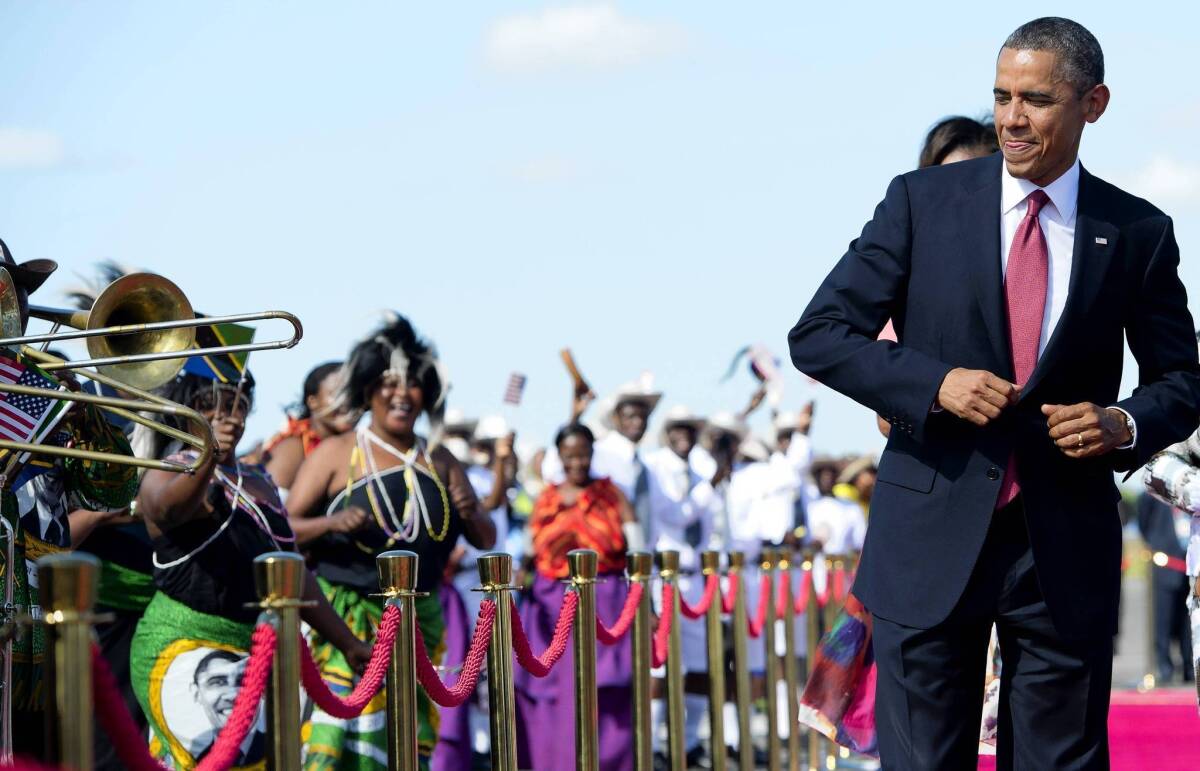In Tanzania, Obama focuses on partnership initiatives

- Share via
DAR ES SALAAM, Tanzania — Flying over East Africa on Monday, a White House official was in the midst of a briefing on a new initiative to combat rhinoceros poaching and big game trafficking when a reporter got stuck on a detail.
“Ten billion or 10 million?” the reporter asked.
“Ten million, yes, with an M,” said Grant Harris, the National Security Council’s senior director for African affairs, to surprised faces. “Yes, million — $10 million.”
It’s not every day this White House, which proposed more than $3.7 trillion in spending in its 2014 budget, highlights a new program that costs less than the government spends in two minutes. But the relatively small poaching initiative reflects a persistent reality that has trailed this president at each stop of his first African tour: Times are tight.
Some past presidents, including George W. Bush, have punctuated their trips here with announcements of new aid or, at least, promises to press Congress to boost foreign assistance. But faced with lawmakers intent on belt-tightening, President Obama has come with a different approach, one that seeks to create more partnerships and to rely more heavily on private investment.
“Given budget constraints, for us to try to get the kind of money President Bush was able to get out of a Republican House for massively scaled new foreign aid programs is very difficult,” Obama told reporters this week, answering a question about his legacy on the continent.
Foreign aid, even though it makes up about 1% of federal spending, is unpopular with Americans, most of whom overestimate how much the U.S. provides and tell pollsters they want the assistance cut.
In Senegal, the White House celebrated the progress of its initiative to improve food production, announcing that efforts to increase crop yields and modernize agricultural practices have reached 7 million people. But there was no pledge of new money.
In South Africa, the White House touted existing programs to fight malaria, tuberculosis and HIV, but promised no additional financial commitment.
The anti-trafficking plan, which the White House says will improve the environment, protect the tourism industry and crack down on criminal networks, includes a task force and one new U.S. Fish and Wildlife officer in the region.
The notable exception has been the $7 billion in support Obama promised for his Power Africa program, an initiative announced Sunday to double access to electricity across the sub-Saharan region of the continent. But even that price tag reflects a shift from straight assistance, relying heavily on money from other government-funded entities: the Export-Import Bank and loans from the Overseas Private Investment Corp. The U.S. Agency for International Development will spend $285 million and the Millennium Challenge Corp., a Bush-era aid program, will invest up to $1 billion in African utility systems. Private companies have promised $9 billion to upgrade power systems.
By comparison, Bush sought $15 billion in 2003, when he first launched his emergency AIDS relief effort. And Congress approved $19 billion.
Obama has bristled at comparisons with Bush, whom he will see in Tanzania on Tuesday at a ceremony honoring those killed in the 1998 attack on the U.S. Embassy here. Bush and his wife, Laura, are in the country for a summit of African first ladies, which First Lady Michelle Obama will also attend.
The budget climate has changed since Obama’s Republican predecessor launched his initiatives. With deficit talks stalled and another budget fight with Republicans on the horizon, Obama is unlikely to receive support for any major new aid program.
During Obama’s tenure, funding for the AIDS relief program, known as the U.S. President’s Emergency Plan for AIDS Relief, or PEPFAR, has fallen $228 million from a high in 2010 of $6.9 billion. Obama requested $6.7 billion for fiscal 2014.
The White House argued that new technologies and bureaucratic changes had enabled the program to do more with less money. The administration is also in the process of handing over control and responsibility for funding PEPFAR to South Africa.
It’s that sort of shift that Obama has emphasized as he tours the continent. Partnerships and leveraging private investment, rather than foreign aid, are the “new model” for development in Africa, he said.
“We don’t want to just provide food, we want to increase food self-sufficiency,” Obama said at a news conference with Tanzanian President Jakaya Kikwete. “So ultimately, the goal here is for Africa to build Africa for Africans.”
That he is not coming to spread around U.S. largesse has not damped enthusiasm in Senegal, South Africa and Tanzania for the first African American U.S. president.
Obama arrived here Monday for the final leg of his tour and received his biggest reception yet. Throngs crowded the sidewalks in the heat to catch a glimpse of his motorcade on its way to the State House, a gated presidential compound facing the crystal blue waters of the Indian Ocean.
Women wore wrap skirts, or khanga, bearing Obama’s visage. They waved flags and snapped pictures as the presidential limousine cruised along the newly renamed Barack Obama Boulevard.
kathleen.hennessey@latimes.com
More to Read
Sign up for Essential California
The most important California stories and recommendations in your inbox every morning.
You may occasionally receive promotional content from the Los Angeles Times.














